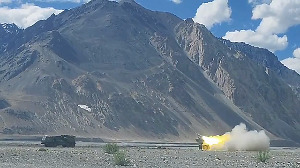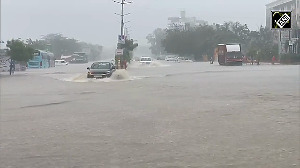Exactly 60 days after rains exposed the inadequacies of Mumbai's civic agencies, rediff.com finds out what measures are in place to avoid a repeat of 26/7.
Soon after the deluge, the BrihanMumbai Municipal Corporation reconstituted the disaster management committee. Though a chunk of responsibility lies with the Corporation, the police, the railways, the airport authorities and BEST are also part of the committee.
The police
Though the police can do the least, they are the most visible arm of the administration and hence are prone to receive more brickbats in times of crisis, police officers say.
The representative from the police in charge of disaster management, Joint Commissioner of Police, Traffic, Satish Mathur says his department has studied the problem and have solutions, at least on paper.
'Police not in disaster management plan'
"Yes, we can only give suggestions. At the end of the day, whether any plan sees the light of the day depends on the Corporation," Mathur said.
The police say during the run up to the monsoon, based on statistics from 2004 they sent several warnings to the Corporation about precautionary measures that had to be in place.
"Last year, the day that saw the highest rainfall witnessed 74 trees falling. I wrote about this to the authorities concerned. Was anything done? 54 trees fell on July 26," said Assistant Commissioner of Police, Traffic, Sanjay Dani.
He says the traffic police are in the best position to monitor ground realities and keep the other agencies posted. "We are easily the most visible arm of the administration, my constables see drains flooding, trees about to fall, water rushing into low lying areas. We usually call for a meeting of all the agencies and relay what our men see. Most agencies never attended that meeting at all. There are other coordination problems too, says Mathur.
"Just before the monsoon, we suggested that a Corporation official be positioned at our control room so that we could keep the public informed through our public address system. That idea was shot down. We suggested that huge electronic boards be put up in strategic locations so that the situation in the city could be flashed for the public's benefit. The Corporation sat on it for months. Then after 26/7 they have agreed to put up boards at Marine Drive (south Mumbai), Mahim (northcentral Mumbai), the airport and a couple of other spots," Mathur said.
Adds Dani: "In Matunga (northcentral Mumbai), BEST buses and a lot of cars got stuck in the water, blocking traffic. Not more than 100 feet away, BEST cranes were stationed. Those guys wouldn't move those cranes. Reason: We don't have our superiors' permission!"
The police say though they were well prepared even before 26/7, they have chalked out plans so that they will be in a better position.
BEST
BrihanMumbai Electricity Supply and Transport company General Manager K S Kshatriya doesn't deny the last mentioned charge of the police. "Yes, certain things did happen. But we have improved our coordination with other agencies."
Apart from poor co-ordination, Kshatriya says, things were fine. "We had a disaster management plan in place. Buses were running, electricity supply was not interrupted apart from those places where we had to cut power supply due to the fear of people being electrocuted," he said.
What are the measures that BEST has taken after 26/7?
Kshatriya says a new method of providing power even to water logged areas without the fear of people getting electrocuted will soon be put in place. "Called Quantum redundancy, we will shut down the power station in the flooded areas and resume supply from an alternate power station. This way there won't be power cuts and the public need not worry about stepping in the water.
Regarding buses, Kshatriya says BEST understands how important its responsibility is in case the trains stop. "We have developed a two-pronged strategy. We have identified low-lying areas along the rail line and also in places where train services are not available. We have deployed 400 buses connecting these low-lying areas to the train stations. In places where reaching a train station is difficult, we have identified depots in higher planes, where people can be moved," he said.
Central and Western Railway
The first train on the Western line left Andheri, northwest Mumbai, at around 6 am on July 27 and reached Borivali, also in northwest Mumbai, well past 9 am.
"Around 9:50 pm on July 26, we understood things are getting out of hand. The low-lying areas along the line were completely flooded. But we resumed service from Mahalaxmi at around 4 am on July 27," Western Railway Divisional Railway Manager Arunendra Kumar said.
The good work apart, what were the problems identified and how have they been addressed.
"The Mithi river is the main problem. For instance in Matunga, a drain empties into the Mithi, but since the river was overflowing, water could not be pumped from Matunga. We now have installed pumps in Matunga and we are now capable of emptying water from near the tracks.
Build systems, if not leadership
"We also have sealed coaches with non-conducting material in order to prevent electric leakage," he said.
The central line couldn't be thrown open to traffic as quickly as the western line was.
"This was due to heavy flooding and breaches in many points," Central Railway Divisional Railway Manager R S Virdi said.
"All it takes to halt operations is four inches of water. That day nothing was visible as far as anybody could see," he said.
Virdi says the Central Raiway's brief following the rains was a three-point strategy.
"The first was to put in place our own pumping system, so that even if the Corporation is unable to pump out the water, we can do the needful and resume operations in quick time.
"The second is to improve co-ordination with agencies like the BMC and BEST.
"Third and the most important aspect is to keep the public well informed about prevailing situations," he says.
In two months, we will be ready to face a 26/7-like situation or even heavier rainfall than that, he says confidently.
The BrihanMumbai Municipal Corporation
There were two common problems that the above-mentioned agencies had during the rains -- communication with the Corporation, excessive flooding.
Has the Corporation learnt its lessons?
Cut the nonsense and offer Mumbai a chance
Its assistant engineer in charge of the disaster management cell, Amit J Dhave reveals what has changed after 26/7.
"We are revamping the disaster management cell," he said. "We have set up hotlines and communications lines with various other departments. And in the last two months, we have really improved our coordination with other agencies. On September 22, which had the highest rainfall after July 26, we had things completely under control."
He added that Kalina (northwest Mumbai), Kurla (north Mumbai) and Saki Naka (northwest Mumbai) have been identified as critical areas, and three of the six new search and rescue teams of the Corporation have been stationed in these places.
"Lots of lives were lost because people in these areas could not be reached in time. This will not be repeated. With these teams in place, nobody in these areas will be more than 20 minutes from help," he said.
Regarding the railways' grouse that flooding could be avoided, Dhave says the process of de-silting culverts along the railway lines is on in full swing.
"We will also get more gates to stop flooding during heavy rains. Flooding of tracks is a major problem and we are doing our best to tackle it."
Regarding the Mithi river, Dhave says a high level committee has been formed to study the silt pattern, flow pattern and the ecological properties of the river.
"A six-member committee comprising IAS officers and former BMC chief engineers are looking into it. They will file a report in a month's time. An action plan for tackling the problem caused by the Mithi will be evolved soon.
Communicating with the public is another aspect that the Corporation is seeking to improve. "We are planning to procure heavy-duty vehicles fitted with wireless public address system so that the public can also be warned. On September 22, we tied up with BSNL and ensured that cellular users received warning messages."
Mumbai stop praising your resilience
Though corrective measures are being put in place, Dhave has an honest word of caution for Mumbai.
"We have learnt the lesson. We are taking corrective measures, but should a disaster in the magnitude of 26/7 is to hit again, we might manage, but it will be a very tough exercise."






